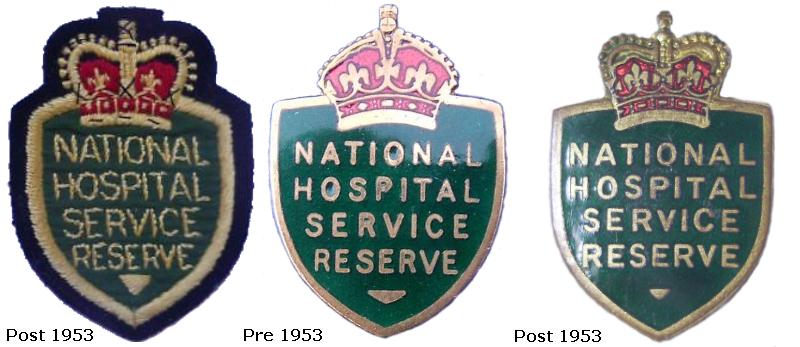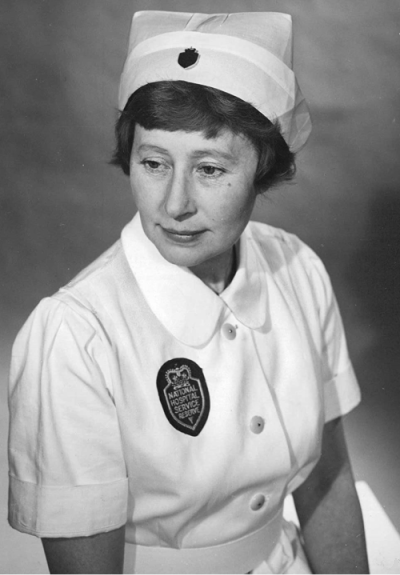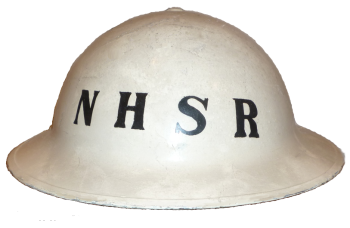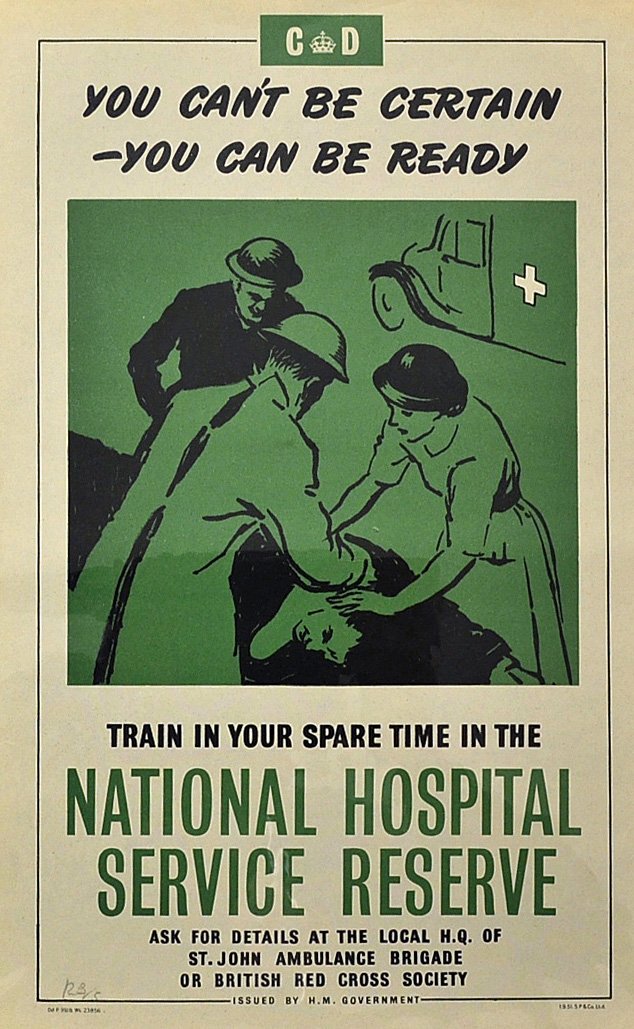National Hospital Service Reserve
"The purpose of the N.H.S.R. [National Hospital Service Reserve] is to recruit, train and organise in peacetime a Reserve of menNHSR badges and women qualified in first aid and home nursing, who would in time of war not only provide the additional staff required for the greatly expanded hospital service, but would also man some 2,000 Mobile First Aid Units and some 800 static first-aid posts at hospitals. Its peacetime target is 100,000 and by the end of last year nearly 35,000 members had been recruited."--British journal of nursing, March 1954, p. 30
The Emergency Hospital Service was part of the Civil Defence Services first established in the 1930s in preparation for air raids that were expected to be part of any future war. It was disbanded in May 1945 when the other Civil Defence Services were disbanded. At the beginning of the Cold War, the need for a NHSR arose. Rising tensions and nuclear proliferation amongst the superpowers lead to real fears of nuclear war breaking out. The basic role of the NHSR would be, in time of war, to supplement the expanded hospital services and work alongside National Health Service staff.
The NHSR was set up under the 1948 Civil Defence Act (UK) and established in 1949. The NHSR was organised by the National Health Service in co-ordination with the Home Office. It was staffed by uniformed volunteers from the nursing and medical professions, of whom most would have been either registered or auxiliary nurses. Many volunteers would also receive training in first aid and auxiliary nursing that would open up new career opportunities for them. Branches of the NHSR were established throughout the UK with County Councils and County Borough Councils being responsible for their administration. NHSR units were formed by local health authorities, and each was based at a major hospital.
Recruitment was via hospitals, the St. John Ambulance, the British Red Cross and the St. Andrews Ambulance. NHSR volunteers wore their normal uniform, where appropriate, and were additionally issued with a white tin hat, a grey greatcoat, a cloth badge to be sewn on to their uniforms, a metal lapel badge and an armband. Each hospital had its own NHSR unit, under the control of a senior officer based at a co-ordinating hospital. Our local NHSR was based at St Helier Hospital in Sutton, Surrey.
Equipment for the NHSR included large tents, hospital beds, stretchers, basic medical supplies and transport vehicles. Units were also equipped with the same RADIAC equipment as the Civil Defence Corps.
Changes
By 1957, although the recruiting e?ort had remained fairly steady, there had been little net increase in membership over the previous two years, there were some 43,000 volunteer members, but the NHSR never achieved its target strength of 100,000. In view of this the service was modified as far as membership and training requirements were concerned.
It was felt that the existent training requirements had deterred many trained nurses and nursing auxiliary members of the voluntary aid societies from joining the Reserve. The members of both the St. John Ambulance Brigade and the British Red Cross Society had a considerable number of duties to which they are committed in the course of their normal peace-time work and any additional nursing experience in hospital needed to be integrated with these existing responsibilities. It was thought that the wealth of training and practical experience must be utilised to the best advantage in the staffing of war-time hospitals, and the main point of the new proposals was the recognition of this fact and the introduction of measures designed to remove, so far as possible, the barriers which had hitherto prevented them from joining in larger numbers.
The nursing auxiliary section of
the Reserve was developed on a basis of co-partnership between the
Hospital Service and the St. John Ambulance Brigade and the British
Red Cross Society with the hospital as the focal point. Close
co-operation with the voluntary aid societies was essential to
create an atmosphere in which their units and all other members of
the National Hospital Service Reserve were encouraged to
regard themselves as a reserve of a particular hospital or group of
hospitals. The memorandum, issued in 1957, contained proposals which
had these objects in view. All concerned with the recruitment and
training of the Reserve were required to work toward the creation of
a body of adequate size and experience. To do this it was thought
essential to maintain the enthusiasm of the volunteers, and that the
development of close ties with the hospitals was one of the most
effective ways of doing this.
In planning for the National Hospital Service Reserve, Hospital authorities were requested to make initial contact with the County/Branch Headquarters of the St. John Ambulance Brigade or British Red Cross Society, who might, in turn, delegate authority to their Divisions or Detachments.
The new changes included:
(a) trained
nurses being able to join without any requirement to undertake
refresher courses, but being encouraged to attend lectures and NHSR
armbandexercises;
(b) nursing
members of the voluntary aid societies who were sponsored by their
agencies were also not required to take any extra training;
(c) nursing
auxiliaries who were not members of a voluntary aid society were
required to undertake a six hour training course simultaneously with
initial training,
(d) the
requirement to serve for a specified period of service during
war-time was modified;
(e) hospital
domestic staff were no longer classed as automatically ineligible,
(f) compulsory medical examination was dispensed with although hospital authorities could exclude from training those who were considered medically unfit.
Training requirements and formats varied, and depended in large part on previous training and experience, and detailed programmes were left entirely to Regional Hospital Boards. RHBs decide the content, length, place and frequency of training sessions. It was envisioned that formal lectures would be avoided, and that these should be replaced by group discussions, films and demonstrations.
Whilst the content of courses was left to the discretion of Regional Boards, the following was recommended content:
- Civil Defence Control
(b) Delayed danger - e.g. principles of protection against the danger of residual radio-activity, use and purpose of radiac instruments etc. (with demonstrations where possible) personal cleansing, decontamination, precautions necessary with food and water.
- The casualty services - the hospital plan.
- The problems of evacuation of staff and patients.
- Practice in packing up for removal - reliance on initiative of individuals
- Special teams for burns - resuscitation - head injuries.
- The setting up of information bureaux, and the correlation of information etc.
4. Shock - modern methods of treatment.
Use and abuse of Morphia - Intravenous infusions - Injection Therapy - Antibiotics.
5. Burns - First Aid - Percentage areas affected - Treatment short and long term.6. Blast Injuries of Chest - Abdomen - Spine - Head and Face and Eye - Fractures - Splinting and Plaster of Paris - Crush Syndrome - Bleeding and the use of Tourniquets.
Care of the unconscious.
7. Radiation following nuclear explosion - Symptoms and treatment.
8. Special Nursing Treatments
- Tracheotomy - Gastric Suction - Intramuscular injections.
- Administration of Oxygen - Prevention of bedsores in special cases.
Forward Medical Aid Units (known in the early days as Mobile First Aid Units)
One of the major roles of the NHSR was the establishment of Forward Medical Aid Units (FMAUs). The idea of these would be that they could be set up in pre-earmarked locations adjacent to areas of significant damage, typical sites would be large schools, colleges and sports facilities. Site requirements included having some large rooms, a large parking area and easy road access. Equipment, including beds, instruments and the like were stored in local depots. During exercises with the Civil Defence Corps, AFS etc, locally we used Sandown Park Racecourse, I understand that Epsom Race Course and Brooklands Technical College, Weybridge were also listed for use in wartime. An FMAU was staffed by four doctors, four nurses and thirty-six nursing auxiliaries, as well as administrative staff.NHSR helmet
The main role of the FMAU was to triage incoming survivors, and to give them limited treatment. Major treatment would not have been possible. Those, who with minor treatment could continue a normal function in society, would be given that treatment and discharged. Otherwise those who stood little chance of survival would receive no treatment other than pain relief if available. There is some evidence that it might have been necessary, in the event of war, to kill those who stood little chance of survival. Other casualties, depending on the availability of further treatment would be transported to a hospital where possible. Examples of minor treatments that would enable someone to function, would be reduction and plastering of simple fractures.
The NHSR took part in major exercises alongside the Civil Defence Corps. I remember that, on one occasion, when my scout troop (1st Walton "Viking" Sea Scouts) provided casualties prior to my joining the Civil Defence Corps, one of us had a 'fractured skull, and was declared "DoA", and another had a 'broken arm' which got a full arm plaster which he wore home and scared his mother with. The casualties had been created from volunteers by the experts of the Casualties Union, an organisation originally established in 1942, and which provided casualties for the the Surrey Civil Defence Service first. Using stage make-up and such things as chicken bones and special mixtures to represent blood, skin and muscle tissue, they were able to create pretty much any injury and they were extremely convincing. "Casualties" who were not members of the CU were given detailed instructions as to how to behave and simulate their role. The Casualties Union is still in existence and regularly provides casualties for a range of training exercises.
The NHSR was finally disbanded on
1st August 1968. It was suggested in the House of Commons that local
health authorities might try to continue something similar at local






